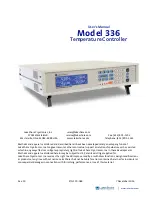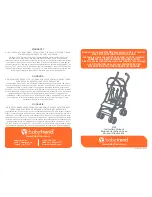
35
The integral gain affects the PID calculation; an increase
will make the IAQ submaster reference change greater as the
error in indoor air quality increases. The integral gain should be
selected to eliminate proportional droop without overshoot.
Enter the desired integral gain for the Indoor Air Quality con-
trol algorithm.
The Derivative Gain is typically not required for Indoor Air
Quality operation and should be left at the default value.
The Starting Value is used to establish the starting value for
the IAQ PID calculation.
The IAQ PID includes the following set points: Proportion-
al Gain, Integral Gain, Derivative Gain, and Starting Value.
Proportional Gain:Range:
–100.0 to 40.0
Default Value:
1.0
Integral Gain:
Range:
–5.0 to 5.0
Default Value:
0.5
Derivative Gain: Range:
–20.0 to 20.0
Default Value:
0.0
Starting Value:
Units:
Percent
Range:
0.0 to 100.0
Default Value:
0.0
ECONOMIZER PID — The proportional gain determines the
response of the PID temperature control loop; a larger gain
increases the amount of damper movement while a smaller
gain requires a larger error to achieve the same results.
The integral gain affects the response of a PID calculation;
an increase in gain will compensate more quickly for propor-
tional control droop. Too large of an integral gain will cause
excessive damper positioning and instability. Enter the desired
integral gain for the damper control algorithm.
The economizer derivative gain has been tested for ideal
operation in sensor mode and should be left at the default value.
NOTE: In thermostat mode, the modulation may appear to
regularly change. However, it will precisely control leaving-air
temperature.
The economizer Starting Value is used to establish the start-
ing value for the damper PID calculation. The value entered is
determined by the mass of the zone. Typically a value of 10%,
the default, will be adequate for most applications. For higher
mass areas, such as a stone lobby, the value may be increased
to 20 to 25%.
The Economizer PID includes the following set points:
Proportional Gain, Integral Gain, Derivative Gain, and Starting
Value.
Proportional Gain:
Range:
–100.0 to 100.0
Default Value:
–4.0
Integral Gain:
Range:
–5.0 to 5.0
Default Value:
–2.0
Derivative Gain:
Range:
–20.0 to 20.0
Default Value:
–3.0
Starting Value:
Units:
Degrees F
(Degrees C)
Range:
48.0 to 120.0
Default Value:
70.0
SUBMASTER GAIN LIMIT — The Submaster Gain Limit
is used to define the submaster gain limit that is multiplied by
the Submaster Error and added to the Submaster Center Value
to produce the output value that will be sent to the device. The
sign of the submaster gain limit determines the direction in
which the output will be driven in response to a given error.
The gain is expressed in percent change in output per
degree of error.
Submaster Gain
Limit Reference:
Range:
–20.0 to 20.0
Default Value:
–5.5
SUBMASTER CENTER VALUE — The Submaster Center
Value is used to define the submaster loop center value which
defines the starting point of the loop. This value typically repre-
sents the midpoint of the range of the device being controlled.
Submaster Center
Value Reference:
Units:
Percent
Range:
0 to 100
Default Value:
60
DAMPER MOVEMENT BAND — The Damper Movement
Band is used to define what the minimum desired range of
change in economizer damper position that is required before
the controller will attempt to open/close the economizer.
Damper Movement
Reference:
Units:
Percent
Range:
0 to 5
Default Value:
0
OAT TEMP BAND — The OAT Temp Band is used to slow
the response of the economizer damper based on the value of
OAT. In other words, the colder OAT gets the slower the rate of
change in the economizer.
OAT Temp
Reference:
Range:
0 to 40 Delta
Degrees F
(Delta Degrees C)
Default Value:
25.0
MINIMUM DAMPER POSITION — The minimum damper
position (MDP) specifies user configured occupied minimum
economizer damper position. The control selects the greatest
value between MDP and IAQ calculated Minimum Position.
The resulting value is the Final Minimum Damper Position
IQMP for Occupied mode.
Economizer Damper is limited to IQMP in Occupied mode,
or whenever Supply Fan is ON in units with Thermostat
control.
Minimum Damper
Position:
Units:
Percent
Range:
0 to 100
Default Value:
20.0
LOW TEMP MINIMUM DAMPER POSITION OVER-
RIDE — The Low Temperature Minimum Damper Position
(MDP) specifies the value for purge minimum damper position
for low outdoor air temperature conditions.
The IAQ Pre-Occupancy Purge Algorithm shall use this
value for the minimum damper position whenever Outdoor Air
Temperature is below Unoccupied OAT Lockout Temperature.
The Low Temperature MDP must be lower than the config-
ured Minimum Damper Position.
Low Temperature
MDP Override:
Units:
Percent
Range:
0 to 100
Default Value:
100
DX COOLING LOCKOUT — The DX (Direct Expansion)
Cooling Lockout function Enables/Disables Low Ambient DX
Cooling Lockout option.
For Version 1.2 — When DX Cooling Lockout is enabled,
Cooling control will compare OAT against the DX Cooling
Lockout Temperature. Whenever OAT <= the DX Cooling
Lockout Temperature and current DX stages are 0, the control
will set Cooling Submaster Reference (CCSR) to 150 F. That
will prevent the unit from staging up.
If the OAT sensor is not installed (OAT point reads –40 F
and “Sensor Failure”), the cooling stages ARE locked out if
DXCTLO is On.
Summary of Contents for PREMIERLINK 33CSPREMLK
Page 43: ......










































